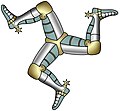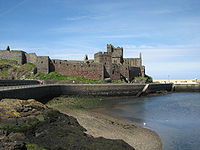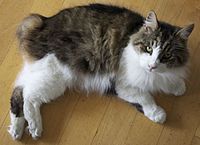Isle of Man
| Isle of Man (crown dependency) | |
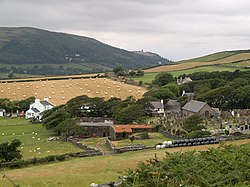 Maughold, Isle of Man | |
|---|---|
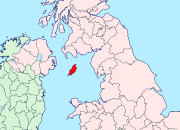
| |
| | |
| Quocunque Jeceris Stabit Whithersoever you throw it, it will stand' | |
| Area: | 221 square miles |
| Population: | 80,085 (2006) |
| Capital: | Douglas |
| Time zone: | Greenwich Mean Time |
| Dialling code: | 01624 |
| TLD: | .im |
The Isle of Man, otherwise known simply as Mann, is a self-governing British Crown Dependency, in the Irish Sea between the islands of Great Britain and Ireland, within the British Isles.
In the Isle of Man, the Queen bears the dual title "Queen and Lord of Mann", since the lordship of Mann was once separate and indeed independent. The Queen is represented by a Lieutenant Governor.
The island has been inhabited since before 6500 BC. It began to be influenced by Gaelic culture in the 5th century AD and the Manx language, a branch of the Gaelic languages, gradually emerged. In the 9th century, the Norse began to settle there. A Norse-Gaelic culture emerged and the island came under Norse control. In 1266, the island became part of Scotland. After a period of alternating rule by the kings of Scotland and England, the island came under the feudal overlordship of the English Crown in 1399. The lordship belonged to the Stanley family from the Middle Ages until it was vested in the British Crown in 1764 under the Isle of Man Purchase Act 1765. The island has never became part of the United Kingdom and has retained its status as an internally self-governing jurisdiction.
Today Isle of Man is a financial centre and tax haven.
Contents
Name of the island
The origin of the name Isle of Man is of lost ancient origin. In the Manx Gaelic language the Isle of Man is known as Ellan Vannin. The earliest surviving form of 'Man' is Manu or Mana.[1]
Some suggest that the island's name is related to the figure in British mythology known as Manannán mac Lir to the Irish and Manawydan to the Welsh.[2]
The name enters recorded history as Mona (Julius Caesar, 54 BC), and is also recorded as Monapia or Monabia (Pliny the Elder, AD 77), Monœda (Ptolemy, AD 150), Mevania or Mænavia (Paulus Orosius, 416), and Eubonia or Eumonia by Irish writers. In Welsh records it is Manaw, and in the Icelandic sagas it is Mön.[3]
Though Mann was never brought into the Roman Empire, the island was noted in Classical Greek and Roman accounts where it was called variously Monapia, Mοναοιδα (Monaoida), Mοναρινα (Monarina), Menavi and Mevania.[4] The Old Welsh and Old Irish names for Mann, Mano and Manau, also occur in Manau Gododdin, the name for an ancient district in north Britain along the lower Firth of Forth.[5] The name is very similar to that of Anglesey, in Welsh Ynys Môn]]; both were known as Mona to the Romans at times, and it may show a Celtic root reflected in the Welsh]] mynydd and Gaelic monadh , meaning "mountain".
The Norse, who ruled the Hebrides and Mann together, named the former the Súðreyjar ("southern isles") in contrast to the Norðreyjar ("northern isles") of Orkney and Shetland. Súðreyjar gives a name to the Church of England's diocese here; the Diocese of Sodor and Man which today only covers the Isle of Man.[6] When the Rev WV Awdry wrote The Railway Series, he invented the island of Sodor as an imaginary island located between Mann and the Cumberland coast.[7]
Geography
The Isle of Man is located in the middle of the northern Irish Sea, approximately equidistant from the islands of Great Britain and Ireland, within the British Isles. The closest land is Wigtownshire.
The island is 32 miles long and, at its widest point, 14 miles wide. It has an area of around 221 square miles. Besides the island of Mann itself, to the Isle of Man belong some nearby small islands: the seasonally inhabited Calf of Man, Chicken Rock on which stands an unmanned lighthouse, St Patrick's Isle and St Michael's Isle. Both of the latter are connected to the mainland by permanent roads/causeways.
Hills in the north and south are separated by a central valley. The extreme north is exceptionally flat, consisting mainly of deposits from glacial advances from western Scotland during colder times. There are more recently deposited shingle beaches at the Point of Ayre. The island has one mountain higher than 2,000 feet, namely Snaefell, standing at 2,034 feet. According to an old saying, from the summit one can see five kingdoms: the Kingdom of England, the Kingdom of Scotland, the Kingdom of Ireland, the Kingdom of Mann and the Kingdom of Heaven.
History
]] Rising water levels cut off the island from the surrounding islands around 8000 BC. Evidence suggests that colonisation of the Isle took place by sea at some time before 6500 BC.[8] The first residents lived in small natural shelters, hunting, fishing and gathering for their food. They used small tools made of flint or bone, which have been found near the coast. Representatives of these artefacts are kept at the Manx Museum.[9]
The Neolithic Period marked the coming of knowledge of farming, better stone tools and pottery. It was during this period that megalithic monuments began to appear around the island. Examples from this period can be found at Cashtal yn Ard near Maughold, King Orry's Grave in Laxey, Meayll Circle near Cregneash, and Ballaharra Stones in St John's. This was not the only Neolithic culture; there were also the local Ronaldsway and Bann cultures.[10]
During the Bronze Age, the large communal tombs of the megalith builders were replaced with smaller burial mounds. Bodies were put in stone lined graves along with ornamental containers. The Bronze Age burial mounds created long lasting markers about the countryside.[11]
The Iron Age marked the beginning of Celtic cultural influence. Large hill forts appeared on hill summits, and smaller promontory forts along the coastal cliffs, while large timber-framed roundhouses were built. It is likely that the first Celtic tribes to inhabit the Island were of the Brythonic variety. Around the 5th century AD, cultural influence from Ireland, probably along with some degree of migration, precipitated a process of Gaelicisation, evidenced by Ogham inscriptions, giving rise to the Manx language, which remains closely related to Irish and Scottish Gaelic.[12]
Scandinavian settlement of Mann began at the end of the 8th century. The Norse established Tynwald and introduced many land divisions that still exist. They also left the Manx Runestones. Although the Manx language does contain Norse influences, they are few. The Norse Kingdom of Mann and the Isles was created by Godred Crovan in 1079 after the Battle of Skyhill. The House of Godred ruled in the island for several generations after him, in time acknowledging the King of Norway as overlord.
In 1266 under the Treaty of Perth, King Magnus VI of Norway ceded the Hebrides and Isle of Man to Scotland, and it fell into the quarrels between the two kingdoms of the greater island. William de Montacute, an English magnate, took possession of the Island in 1333; he descended on the distaff side from Godred.
William le Scrope, later Earl of Wiltshire, bought the island and became King of Mann, but as a close ally of King Richard II, he was captured and beheaded in July 1399 by supporters of Henry Bolingbroke, who within months was King Henry IV. Henry granted the island to Henry Percy, Earl of Northumberland, and a few years later (on Percy's execution) to John Stanley, whose male descendants (in most cases Earls of Derby) held the island and governed it through officers for 330 years. The Stanleys used the title Rex, and later the more modest Dominus. The Stanley line failed in 1736, and the Lordship of the island passed to a collateral line, namely that of the Murray Dukes of Atholl.
Tynwald, created by the Norse, was a weak assembly. In 1737 however the Duke of Atholl approved an Act of Tynwald which, referring to 'the liberties and properties of the people', practically conceded the right of both Branches to participate in legislation.
In the 1760s the British Crown sought greater control over the island, as smuggling from the island to Lancashire and Cumberland was a serious problem. After negotiations with John, Duke of Atholl, the Crown bought the rights of the lordship and by the Isle of Man Purchase Act 1765 they were vested in the Crown. Some rights and prerogatives remained with the Murrays as tenants-in-chief, but the whole Murray estate was bought out in time and in 1828 all had been surrendered and merged into the Crown.
Nevertheless, the island was not incorporated into Great Britain; it remained and remains today a separate Crown dependency.[13]
In 1866, greater autonomy was restored to the island's parliament and a full transition to democracy began. The Isle quickly developed as a finance centre and tourist destination, becoming increasingly prosperous during the 20th century. During both the First and Second World Wars the island was used as a location for internment camps for enemy citizens and suspected sympathisers.
Tynwald
Tynwald, the island's parliament, was nominally founded in AD 979. It is arguably the oldest continuous parliament in the world.[14] The annual ceremonial meeting in July on Tynwald Day, the island's national day, continues to be held at Tynwald Hill, where titles are announced and a brief description of the new laws enacted by Tynwald during the previous year is given.[15]
The Sheadings
The Isle of Man is divided into six sheadings: (map)
These serve as the basis of:
- the districts of the Coroners, and
- certain electoral constituencies.
The origins of the term "sheading" are unclear. There are three main possibilities: From the Norse word skeid, meaning ship-assembly or from a Celtic word meaning sixth part, perhaps introduced from Scotland, or from the Middle English word for an administrative division, scheding.
Economy
The Isle of Man is a low-tax economy with no capital gains tax, wealth tax, stamp duty, or inheritance tax[16] and a top rate of income tax of 20%. A tax cap is in force; the maximum amount of tax payable by an individual is £100,000 or £200,000 for couples if they choose to have their incomes jointly assessed. The £100,000 tax cap equates to an assessable income of approximately £570,000. Personal income is assessed and taxed on a total worldwide income basis rather than a remittance basis. This means that all income earned throughout the world is assessable for Manx tax rather than only income earned in or brought into the Island.
The rate of corporation tax is 0% for almost all types of income, the only exceptions are that the profits of banks are taxed at 10%, as is rental (or other) income from land and buildings situated on Mann.[17][18]
Offshore banking, manufacturing, and tourism form key sectors of the economy. Agriculture and fishing, once the mainstays of the economy, now make declining contributions to the Island's Gross Domestic Product (GDP).
Trade takes place mostly with the United Kingdom. The island is in customs union with the United Kingdom, and related revenues are pooled and shared under the Common Purse Agreement.
The Manx government promotes island locations for making films by contributing to the production costs. Since 1995, over eighty films have been made on the island.
Churches
The predominant religious tradition of the island is Christianity, and the ancient Christian Church of the island is today part of the Church of England, forming the Diocese of Sodor and Man.
The Diocese has an unbroken history from 1154 to the present day, during which there have been many changes in tradition and detail. The diocese has at times been part of the national churches of Norway, Scotland, and England.[19] It has also come under the influence of Irish religious tradition. Since 1541[20] the Diocese of Sodor and Man has been part of the Province of York. It is represented in the General Synod but the Bishop may not sit in the House of Lords in the United Kingdom.
Other Christian churches also operate on Mann. The second largest denomination is the Methodist Church, which is almost as popular as the Church of England. There are also five Baptist churches, four Pentecostal churches, the Salvation Army, two United Reformed churches, as well as other Christian churches.
Culture
The culture of the Isle of Man is influenced by its Celtic, and to a lesser extent its Norse, origins. However, its close proximity to the United Kingdom, popularity as a tourist destination, and recent mass immigration by British migrant workers has meant that British influence has been dominant since the Revestment period. Recent revival campaigns have attempted to preserve the surviving vestiges of Manx culture after a long period of Anglicisation, and significant interest in the Manx language, history and musical tradition has been the result.
Language
The official language of the Isle of Man is English. The last native speaker of Manx Gaelic died in the twentieth century, though leaving a few who could speak Manx as a second language. Recent years have seen an increase in interest and the study of the language. UNESCO classified the Manx language as extinct but changed it to "critically endangered" after complaints from the Manx government.[21]
The Manx Gaelic language is a Goidelic Celtic language and is one of a number of insular Celtic languages spoken in the British Isles. Manx Gaelic has been officially recognised as a legitimate autochthonous regional language under the European Charter for Regional or Minority Languages, ratified by the United Kingdom on 27 March 2001 on behalf of the Isle of Man government.
The Manx language is closely related to the Irish language and Scottish Gaelic. By the middle of the 20th century only a few elderly native speakers remained: the last of them, Ned Maddrell, died on 27 December 1974. By then a scholarly revival had begun to spread to the populace and many had learned Manx as a second language. The first native speakers of Manx (bilingual with English) in many years have now appeared: children brought up by Manx-speaking parents. Primary immersion education in Manx is provided by the Manx government: since 2003, the former St John's School building has been used by the Bunscoill Ghaelgagh (Manx language-medium school). Degrees in Manx are available from the Isle of Man College and the Centre for Manx Studies. Manx-language playgroups also exist and Manx language classes are available in island schools. In the 2001 census, 1,689 out of 76,315, or 2.2% of the population, claimed to have knowledge of Manx, although the degree of knowledge in these cases was presumably varied.
In common use are the greetings moghrey mie and fastyr mie which mean good morning and good afternoon respectively. The Manx language knows no evening as it is afternoon. Another frequently heard Manx expression is traa dy liooar meaning time enough, and represents a stereotypical view of the Manx attitude to life.
Symbols
For centuries, the island's symbol has been its ancient triskelion, a device similar to Sicily's Trinacria: three bent legs, each with a spur, joined at the thigh. The Manx triskelion does not appear to have an official design; government publications, currency, flags, the tourist authority and others all use different variants. Most, but not all, preserve rotational symmetry, some running clockwise, others anti-clockwise. Some have the uppermost thigh at 1200 on the clock face, others at 1130 or 1000, etc. Some have the knee bent at 90°, some at 60°, some at closer to 120°. Also, the degree of ornamentation of the leg wear and spur varies considerably.
The three legs are reflected in the island's motto (adopted late in the symbol's history): Quocunque Jeceris Stabit, traditionally translated from Latin as Whithersoever you throw it, it will stand, or Whichever way you throw it, it will stand.
The origin of the Three Legs of Man (as they are usually called) is explained in the Manx legend that Manannán mac Lir repelled an invasion by transforming into the three legs and rolling down the hill and defeating the invaders.
Variations on the Manx triskelion are still in use on the coats of arms belonging to the different branches of the ancient Norwegian noble family that ruled Mann until the 13th century. This particular version belongs to the Skancke branch of the Skanke family. The name stems from skank, the Norwegian version of the word shank, or leg. The Norse royal family of Mann stayed on the island for some years after the death of Magnus III and the beginning of Scottish rule. The family only emigrated after the final attempt by the Manx to restore the old Sudreyar dynasty in the 1275 uprising against the Scots. This revolt failed disastrously, ending in the deaths of hundreds of rebels, including the last Norse King of Mann, Godred VI Magnuson when the Manx suffered defeat in the decisive Battle of Ronaldsway, near Castletown. When the Norse-Manx royals arrived in Norway they took service as nobles of the Norwegian king, quickly becoming knights, landlords, and clergy under the Norwegian Crown.
Myth, legend and folklore
In Manx mythology, the island was ruled by Manannán mac Lir, a sea god, who would draw his misty cloak around the island to protect it from invaders. One of the principal theories about the origin of the name Mann is that it is named after Manannan.
In the Manx tradition of folklore, there are many stories of mythical creatures and characters. These include the Buggane, a malevolent spirit who according to legend blew the roof off St Trinian's Church in a fit of rage; the Fenodyree; the Glashtyn; and the Moddey Dhoo, a ghostly black dog who wandered the walls and corridors of Peel Castle.
Mann is also said to be home to mooinjer veggey (fairies), known locally as the little folk or themselves. There is a famous Fairy Bridge and it is said to be bad luck if one fails to wish the fairies good morning or afternoon when passing over it. It used to be a tradition to leave a coin on the bridge to ensure good luck. Other types of fairies are the Mi'raj and the Arkan Sonney.
An old Irish story tells how Lough Neagh was formed when Ireland's legendary giant Fionn mac Cumhaill (commonly anglicised to Finn McCool) ripped up a portion of the land and tossed it at a Scottish rival. He missed, and the chunk of earth landed in the Irish Sea, thus creating the island.
Peel Castle has been proposed as a possible location of the Arthurian Avalon [22][23] or as the location of the Grail Castle, site of Lancelot's encounter with the sword bridge of King Melegaunt. [24]
Manx animals
There are two domestic animals specifically connected to the Isle of Man, though they are also found elsewhere.
The Manx cat is a breed of cat noted for having a genetic mutation that causes it to have a shortened tail. The length of this tail can range from a few inches, known as a "stumpy", to being completely nonexistent, or "rumpy". Manx cats display a range of colours and usually have somewhat longer hind legs compared to most cats. The cats have been used as a symbol of the Isle of Man on coins and stamps and at one time the Manx government operated a breeding centre to ensure the continuation of the breed.[25]
The Manx Loaghtan sheep is a breed native to the island. It has dark brown wool and four or sometimes six horns. The meat is considered to be a delicacy. There are several flocks on the island and others have been started in England and Jersey.
Food
Traditionally the national dish of the island is Spuds and Herrin, boiled potatoes and herring. This plain dish is chosen because of its role supporting the subsistence farmers of the island, who crofted the land and fished the sea for centuries.
A more recent claim for the title of national dish would be the ubiquitous chips, cheese and gravy. This dish, which is similar to poutine, is found in most of the island's fast-food outlets, and consists of thick cut chips, covered in shredded Manx Cheddar cheese and topped with a thick gravy.[26]
Seafood has traditionally accounted for a large proportion of the local diet. Although commercial fishing has declined in recent years, local delicacies include Manx kippers (smoked herring) which are produced by the smokeries in Peel on the west coast of the island, albeit mainly from North Sea herring these days. The smokeries also produce other specialities including smoked salmon and bacon.
Crab, lobster and scallops are commercially fished, and the Queen Scallop (Queenies) is regarded as a particular delicacy, with a light, sweet flavour. Cod, ling and mackerel are often angled for the table, and freshwater trout and salmon can be taken from the local rivers and lakes, supported by the Government fish hatchery at Cornaa.
Cattle, sheep, pigs and poultry are all commercially farmed, Manx lamb from the hill-farms being a popular dish. The Loaghtan, the indigenous breed of Manx sheep, has a rich, dark meat that has found favour with chefs, featuring in dishes on the BBC's MasterChef series.
Manx cheese has been a particular success, featuring smoked and herb-flavoured varieties and is stocked by many of Britain's supermarket chains. Manx cheese took bronze medals in the 2005 British Cheese Awards, and sold 578 tonnes over the year.
Sports
The Isle of Man is represented as a nation in the Commonwealth Games and the Island Games and will be hosting the IV Commonwealth Youth Games in 2011. Manx athletes have won three golds at the Commonwealth Games, the most recent being in 2006 by cyclist Mark Cavendish in the Scratch race. The island started the Island Games in 1985, and also hosted the Island Games in 2001.
Isle of Man teams and individuals participate in many sports both on and off the island including rugby union, football, gymnastics, hockey, netball, bowling and cricket. It being an island, many types of watersports are also popular with residents.
Motorcycle racing
The main international event associated with the island is the Isle of Man Tourist Trophy race, colloquially known as "The TT",[27] which began in 1907. It takes place in late May and early June. The TT is now an international road racing event for motorcycles, which used to be part of the World Championship, and is long considered to be one of the "greatest motorcycle sporting events of the world".[28] Taking place over a two week period, it has become a festival for motorcycling culture, makes a huge contribution to the island's economy and has become part of Manx identity.[29] For many, the Isle carries the title "road racing capital of the world".[30]
The Manx Grand Prix is a separate motorcycle event for amateurs and private entrants that uses the same 37.72-mile[[31] Snaefell Mountain Course in late August and early September.
Cammag
Cammag is the national sport of Mann. It is similar to the Irish hurling, and the Scottish game of shinty. Once the most popular sport on the island, it ceased to be played by the start of the 20th century, but has recently been revived, with an annual match at St John's.
Outside links
- Isle of Man Weather
- Isle of Man News
- isleofman.com The Isle of Man online.
- Isle of Man Guide
- Manx Government A comprehensive site covering many aspects of Manx life from fishing to financial regulation
- Manx Wiki
- All about life on the Isle of Man
- Isle of Man Airport
References
- ↑ Kinvig, R.H. (1975). The Isle of Man. A Social, Cultural and Political History. (3rd ed.). Liverpool University Press. p. 18. ISBN 0-85323-391-8
- ↑ Kneale, Victor (2006). "Ellan Vannin (Isle of Man). Britonia.". in Koch, John T.. Celtic Culture: A Historical Encyclopedia. Santa Barbara: ABC-CLIO. p. 676
- ↑ Kinvig, R.H. (1975). The Isle of Man. A Social, Cultural and Political History. (3rd ed.). Liverpool University Press. pp. 18–19. ISBN 0-85323-391-8
- ↑ The Place Names of Roman Britain pp 410–411 (Batsford)
- ↑ Koch, John T. (2006). Celtic Culture: A Historical Encyclopedia. ABC-CLIO Ltd. p. 676. ISBN 978-1851094400
- ↑ Diocese of Sodor and Mann - Manx Notebook site
- ↑ Sibley, Brian (1995). The Thomas the Tank Engine Man. Heinemann. p. 154. ISBN 0 434 96909 5
- ↑ Bradley, Richard (2007). The prehistory of Britain and Ireland. Cambridge University Press. p. 8. ISBN 0521848113
- ↑ Manx Museum Mesolithic collections
- ↑ Manx Museum Neolithic collections
- ↑ Manx Museum Bronze Age collections
- ↑ Manx Museum Celtic Farmers (Iron Age) collections
- ↑ Manx Notebook website, Act of Revestment
- ↑ Both the Icelandic Alþing and the Faroe Islands' Løgting were established earlier, but were abolished from 1800 to 1845 and 1816 to 1852, respectively and recreated only later.
- ↑ Tynwald website
- ↑ Direct Tax - Isle of Man Government
- ↑ Assessor of Income Tax - Isle of Man Government
- ↑ Forget Monaco: Isle of Man cuts tax to tempt super-rich - Tax, Money - Independent.co.uk
- ↑ Moore, A.. "Diocesan Histories. Sodor and Mann.". http://www.isle-of-man.com/manxnotebook/fulltext/dh1893/index.htm.
- ↑ Act of Parliament (1541) 33 Hen.8 c.31
- ↑ "UNESCO accepts Manx language is not 'extinct'". Isle of Man Government. 2009-08-19. http://www.gov.im/lib/news/cso/unescoacceptsman.xml. Retrieved 2009-08-20.
- ↑ Avalon's Location
- ↑ Isle of Man
- ↑ King Arthur, Norma Lorre Goodrich, Harper and Row, 1989, p. 318
- ↑ "Origin of Manx cat breed". http://www.karellomanx.com/origin.html.
- ↑ Isle of Man - Factfile - Daily Life
- ↑ Wright, David. 100 Years of the Isle of Man TT: A Century of Motorcycle Racing. The Crowood Press, 2007
- ↑ Disko, Sasha. The Image of the "Tourist Trophy" and British Motorcycling in the Weimar Republic. International Journal of Motorcycle Studies, Nov 2007
- ↑ Vaukins, Simon. The Isle of Man TT Races: Politics, Economics and National Identity. International Journal of Motorcycle Studies, Nov 2007
- ↑ Faragher, Martin. "Cultural History: Motor-Cycle Road Racing." A New History of the Isle of Man Volume V: The Modern Period 1830-1999. Ed. John Belchem. Liverpool: Liverpool University Press, 2000
- ↑ page 4
Books
- Moore, Arthur William (1903). Manx Names (Revised Cheap ed.). London: Elliot Stock (published 1906). http://books.google.com/?id=FvsEAAAAIAAJ&printsec=frontcover.
- Russel, G. (1988). Distribution and development of some Manx epiphyte populations. 477–492.
- Sacheverell, William (1859). Cumming, Joseph George. ed. An Account of the Isle of Man. Douglas: The Manx Society. http://books.google.com/?id=dIYNAAAAYAAJ&printsec=frontcover.
- Waldron, George (1726). Harrison, William. ed. A Description of the Isle of Man. Douglas: The Manx Society. 1865. http://books.google.com/?id=Ix4tAAAAMAAJ&pg=PR5.





